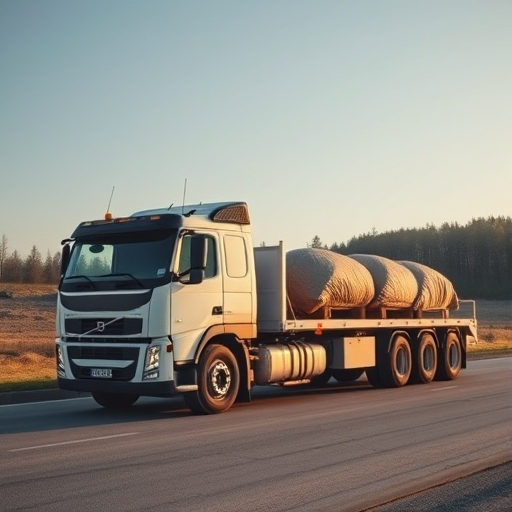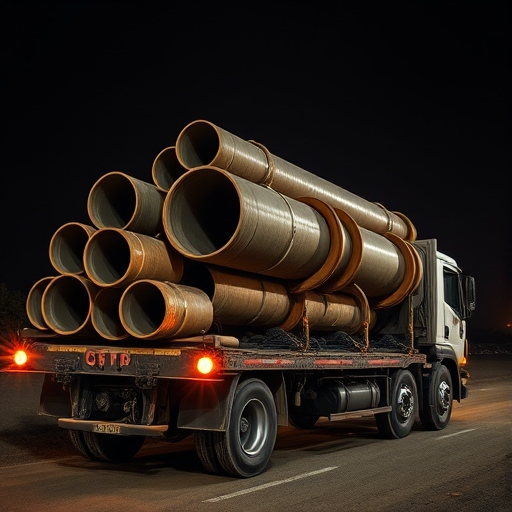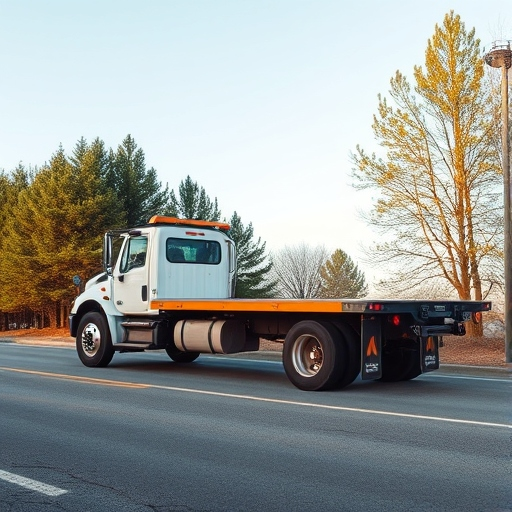Flatbed trucks are the backbone of freight transportation, offering a versatile and reliable solution for hauling cargo of all shapes and sizes.
Unlike traditional enclosed trailers, these trucks provide an open, flat platform, making them ideal for transporting large, bulky, or irregularly shaped items that wouldn’t fit in standard truck trailers.
Whether it’s construction materials, heavy machinery, or oversized loads, flatbed trucks are essential in a wide range of industries.
One of the key advantages of these trucks is their adaptability. With various types like step deck trailers, extendable flatbeds, and lowboys, they can handle everything from standard freight to complex, oversized loads.
Their open design allows for easy loading and unloading from all sides, improving efficiency and safety in the shipping process. As industries continue to demand more specialized hauling options, flatbed trucks remain an indispensable part of the trucking world.
In this blog, we’ll dive into the different types of flatbed trucks, their uses, and the important factors to consider when choosing the right one for your cargo needs.
1. What Are Flatbed Trucks?
A flatbed truck is a type of vehicle designed with a flat, open bed that lacks sides or a roof, making it ideal for transporting large, heavy, or bulky cargo.
Unlike enclosed trailers, which are used for goods that require protection from the elements, these trucks provide an open platform, allowing for easy loading and unloading from all sides.
This unique design makes these trucks versatile and essential for hauling items like construction materials, heavy machinery, and oversized equipment that don’t fit the standard dimensions of traditional trailers.
The flatbed’s open structure not only accommodates larger loads but also allows for quicker and more efficient loading and unloading, reducing downtime for drivers.
Whether it’s a step deck trailer or a standard flatbed, these trucks are often the go-to solution when transporting items that need to be secured and transported without being shielded from weather conditions.
A flatbed truck’s versatility and adaptability make it a key player in the transportation industry.

2. Types of Flatbed Truck Trailers
Step Deck Trailers
Step deck trailers, also known as drop deck trailers, have a unique design with a lower deck height at the rear, allowing for taller cargo to be transported without exceeding height limits.
This trailer type is commonly used for transporting items like machinery, lumber, or construction materials that require additional clearance.
The step deck’s versatility makes it a popular choice for both short and long-haul transportation.
Extendable Flatbeds
Extendable flatbeds are designed to carry extra-long loads. These trailers can be extended to accommodate oversized cargo such as long pipes, beams, or equipment.
They are perfect for industries that regularly transport large, unwieldy items that exceed the standard length of a regular flatbed truck.
Their extendable feature helps in providing flexibility and versatility to meet diverse hauling needs.
Stretch Single-Drop Deck
Stretch single-drop decks are a variation of flatbed trailers with a lower, single drop between the truck and trailer.
This design helps carry taller loads by lowering the deck while still maintaining a single-level structure.
These trailers are particularly useful for hauling construction equipment and oversized machinery that needs a lower center of gravity for safe transportation.
Double Drop Trailers
Double drop trailers feature two drops in their structure, one closer to the truck and another further down the deck.
This allows for extremely tall loads to be transported safely under height restrictions.
Double drop trailers are ideal for carrying heavy machinery, construction equipment, and other large items that need extra height clearance during transport, providing added stability and support.
Lowboy Trailers
Lowboy trailers are low to the ground, making them an excellent choice for transporting oversized loads such as heavy equipment or construction machinery.
Their low height reduces the risk of exceeding height regulations and allows for easier loading and unloading.
Commonly used in the construction and industrial sectors, lowboys are designed to support very heavy loads without compromising safety or stability.
RGN (Removable Gooseneck) Trailers
Removable Gooseneck (RGN) trailers are designed with a detachable front end that allows the trailer to be lowered to the ground, providing an easy ramp for loading and unloading heavy equipment.
They are especially suitable for transporting large, heavy machinery or construction vehicles. The ability to detach the gooseneck provides a unique advantage, as it allows for more flexible and secure transport.
Side-Kit Trailers
Side-kit trailers are flatbeds equipped with removable sides or walls that provide additional load security. They are typically used for transporting goods that need extra protection from the elements but do not require full enclosure.
These trailers are perfect for hauling construction materials, bulk goods, or items that need to be kept contained during transport while still offering easy access for loading and unloading.
3. Flatbed Truck Dimensions and Load Capacity
Flatbed Truck Dimensions
Flatbed trucks come in various sizes to accommodate different types of cargo, with the most common flatbed dimensions being 48 to 53 feet in length, 8.5 feet in width, and a height of around 5 feet.
These dimensions allow for the safe transportation of standard loads while adhering to regulatory restrictions. However, custom flatbeds may vary slightly in size to cater to specific industry needs.
Flatbed Load Capacity
Flatbed load capacity depends on the type of trailer being used. Standard flatbed trailers typically have a load capacity ranging from 40,000 to 48,000 pounds.
For specialized trailers like lowboys or RGNs (Removable Gooseneck), the load capacity can increase significantly.
Lowboy trailers, for instance, are designed to carry extremely heavy machinery and equipment, with a load capacity often exceeding 50,000 pounds.
RGNs are also built for heavy loads, especially large machinery, and can handle similar weight limits due to their reinforced design.
Choosing the Right Trailer for Your Cargo
The load capacity and dimensions of a flatbed truck are crucial considerations when choosing the right trailer for a specific job.
Depending on the cargo size, weight, and other factors, different flatbed types like RGN or lowboy trailers offer enhanced capacity and flexibility for hauling large or heavy loads, ensuring safe and efficient transportation.
4. Materials Used in Flatbed Construction
Steel:
Steel is the most commonly used material in flatbed truck construction due to its durability and strength. It can withstand heavy loads and harsh conditions, making it ideal for transporting large and bulky cargo.
Steel is relatively cost-effective compared to other materials, though it can add weight to the trailer, affecting fuel efficiency.
Aluminum:
Aluminum is another popular material used in flatbed construction. It’s significantly lighter than steel, which helps improve fuel efficiency and allows for larger payloads.
While aluminum is more expensive, its corrosion resistance and lighter weight make it a great choice for industries that require long-lasting and efficient equipment.
Composite Materials:
Some flatbed trucks incorporate composite materials like fiberglass and reinforced plastics. These materials offer excellent strength-to-weight ratios and are resistant to corrosion, although they’re typically more expensive.
Composite materials are increasingly being used in high-tech flatbed designs to enhance performance and durability.
In summary, flatbed construction materials such as steel, aluminum, and composites each offer distinct advantages depending on the use case, balancing cost, weight, and durability.
5. Safety Features and Regulations for Flatbed Trucks
Safety Features for Flatbed Trucks
Flatbed trucks require specific safety features to ensure secure transportation of cargo. The most essential components include straps, chains, and tarps, which help secure the load during transit.
Straps are used to hold the cargo in place, while chains provide additional strength for heavier or more challenging loads. Tarps are essential for protecting goods from weather conditions, such as rain, wind, or sun exposure.
These accessories not only safeguard the cargo but also minimize the risk of accidents caused by shifting loads.
Flatbed Regulations
In addition to safety features, flatbed truck drivers must adhere to several flatbed regulations to maintain road safety.
The Department of Transportation (DOT) has strict rules governing how cargo should be secured, particularly for flatbed trucks, where loads are more exposed.
Drivers must ensure that loads are properly restrained and that all safety equipment is in good condition before hitting the road.
One key regulation is the Cargo Securement Rule, which mandates specific methods for securing cargo to prevent it from moving during transport.
The Federal Motor Carrier Safety Administration (FMCSA) also requires flatbed truck operators to undergo training in load securement to comply with national safety standards.
By adhering to safety features and regulations, flatbed truck drivers play a critical role in reducing road accidents and ensuring the safe delivery of goods.
Compliance with these safety guidelines is vital not only for the driver’s safety but also for the protection of the public and the integrity of the cargo being transported.
6. Common Cargo Transported by Flatbed Trucks
Flatbed trucks are ideal for transporting oversized, heavy, or bulky cargo that traditional enclosed trucks cannot accommodate. They are often used for carrying construction materials, machinery, lumber, and large equipment.
Their open design allows for easy loading and unloading, especially for goods that require cranes or forklifts.
One of the most common cargo types for flatbeds is construction materials such as steel beams, concrete blocks, and prefabricated components.
These items are often too large or heavy to fit in standard enclosed trailers, making flatbeds a preferred choice.
Heavy machinery, including bulldozers, excavators, and other industrial equipment, also frequently travels on flatbed trucks due to their size and weight.
Lumber is another staple cargo transported on flatbed trucks, with the flat surface providing ample space to stack and secure large quantities of wood.
Additionally, flatbeds are used to carry piping, steel plates, and even wind turbine blades, which require the flatbed’s spacious design and secure load capabilities.
Thanks to their versatility, flatbed trucks can efficiently transport a wide range of cargo types that would otherwise be difficult to move using other trailer types.
Their ability to carry oversized and heavy loads is one of the key reasons they are an essential tool in industries like construction, agriculture, and heavy manufacturing.

7. Choosing the Right Flatbed for Your Business
When selecting a flatbed truck for your business, it’s essential to evaluate your specific needs.
Different flatbed trucks cater to various cargo types, industries, and operational requirements. Here are some key factors to consider when choosing the right flatbed for your business:
Cargo Type and Size
One of the first things to consider is the size and type of cargo you’ll be transporting.
For example, if you’re transporting oversized or heavy equipment, a lowboy trailer or RGN (Removable Gooseneck) trailer may be necessary to handle the weight and dimensions.
On the other hand, for lighter loads such as construction materials or lumber, a standard flatbed truck might be sufficient.
Budget and Cost Considerations
Cost is always an important factor when choosing any vehicle. It’s crucial to balance your budget with the type of flatbed truck you need. While steel flatbeds are cost-effective and durable, aluminum flatbeds offer lighter weight and better fuel efficiency but come at a higher price point.
Required Features
Consider any specific features you may need, such as side-kit trailers for added load protection or step deck trailers for extra height clearance.
Also, think about flatbed regulations and whether you need additional safety equipment like straps, chains, or tarps to secure your loads properly.
By carefully evaluating your cargo needs, budget, and necessary features, you can make a well-informed decision when selecting the best-flatbed truck for your business.
8. Innovative Flatbed Designs and Emerging Trends
The flatbed trucking industry continues to evolve with innovative flatbed designs that enhance efficiency, reduce costs, and improve safety.
One major trend is the use of lightweight materials such as aluminum and composite materials. These materials reduce the overall weight of the trailer, leading to improved fuel efficiency and a higher payload capacity without sacrificing durability.
Another exciting development is the rise of hybrid flatbeds. These trailers combine traditional flatbed features with modern technologies, like adjustable heights, making them more versatile for different types of cargo.
Tech-enabled solutions are also making their mark, with load monitoring systems becoming increasingly common. These systems help track cargo weight, ensuring compliance with weight limits and providing real-time data to improve routing and scheduling efficiency.
These innovative flatbed designs and emerging trends are helping companies stay competitive, improve operations, and meet the evolving demands of the trucking industry.

9. Flatbed Truck Maintenance Tips
Proper flatbed maintenance is essential for ensuring the safety, efficiency, and longevity of your truck. Regular maintenance not only prevents costly repairs but also enhances the safety of your loads.
Start with checking load straps and securing systems to ensure they are in good condition and ready to handle heavy or oversized cargo. Over time, wear and tear can weaken straps, posing a risk to both the driver and the cargo.
Also, regularly inspect tire pressure to avoid blowouts or uneven wear. Low tire pressure can lead to poor fuel efficiency and potentially dangerous situations on the road.
Don’t neglect the braking system—check the brake pads and fluid levels to ensure they are functioning properly. Flatbed trucks often carry heavy loads, so reliable braking performance is critical.
By following these flatbed maintenance tips, you can keep your truck running smoothly, extend its lifespan, and minimize downtime.
10. How 24/7 truckin can help flatbed truckers
Flatbed trucks are essential for transporting large, heavy, and oversized loads across various industries. Their versatility, combined with the right equipment, ensures that flatbed truckers can handle a wide range of cargo efficiently and safely.
Whether you’re hauling construction materials, machinery, or other bulky goods, selecting the right flatbed truck is crucial for maximizing productivity.
At 24/7 Truckin, we understand the unique needs of flatbed truckers. Our platform provides access to a range of tools to help you find the right loads, manage your operations efficiently, and track your cargo in real time.
We offer solutions tailored to your needs, helping you stay ahead in the competitive flatbed trucking industry.
If you’re ready to take your flatbed trucking business to the next level, reach out to 24/7 Truckin for expert advice, reliable load management, and the tools you need for success. Explore our platform today and get the support you need to thrive with your flatbed truck.
